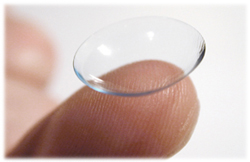 RGP Contact Lenses
RGP Contact Lenses
Gas permeable contact lenses are rigid lenses made of durable plastic that transmits oxygen. These lenses also are called GP lenses, rigid gas permeable lenses, RGP lenses and oxygen permeable lenses.
GP contact lenses are rigid, but they shouldn’t be confused with old-fashioned hard contact lenses, which are now obsolete. Hard contact lenses were made of a material known as PMMA. Before 1971, when soft contact lenses were introduced, just about all contact lenses were made from PMMA.
Gas permeable contacts were first introduced in the late 1970s; they are actually a newer technology than soft lenses. Most GP lenses incorporate silicone, which makes them more flexible than PMMA. And silicone is oxygen permeable, so oxygen can pass through GP lenses, resulting in greater comfort and better eye health.
In fact, gas permeable contacts transmit more oxygen to the eye than do traditional soft contact lenses (although some silicone hydrogel soft lenses are comparable to GP lenses in oxygen transmission).
RGP lenses also provide better vision, durability, and deposit resistance than soft contact lenses. And because they last longer than soft lenses, they can be less expensive in the long term.
The Benefits of RGP Lenses
Gas permeable contact lenses offer some outstanding benefits over soft lenses. For one, because GP lenses are made from a firm plastic material, they retain their shape when you blink, which tends to provide sharper vision than pliable soft lenses.
GP lenses also are extremely durable. Although you can break them (for instance, if you step on them), you can’t tear them easily, like soft lenses.
And they’re made of materials that don’t contain water (as soft contact lenses do), so protein and lipids from your tears do not adhere to GP lenses as readily as they do to soft lenses.
With a little care, gas permeable contact lenses can last for years, as long as you don’t require a prescription change.